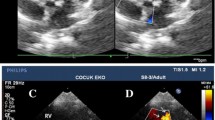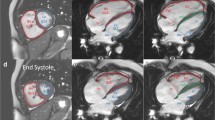Summary
Left ventricular function was examined angiographically in 64 patients with ventricular septal defect and 13 postoperative patients with a preoperatively large shunt (postoperative group). The unoperated 64 patients were divided into three groups; small (left-to-right shunt ratio <35%), moderate (35%–50%), and large (>50%). The control group consisted of 27 patients with Kawasaki disease. For assessing left ventricular function, left ventricular shape and the end-systolic wall stress to end-systolic volume index ratio, as well as left ventricular ejection fraction were examined. Left ventricular ejection fraction was higher in the small-shunt group (p<0.05) than in the control group, but normal in the other groups. Left ventricular end-diastolic shape was normal only in the small-shunt group and more spherical in the other groups. The large-shunt group alone manifested more spherical left ventricular end-systolic shape and lower end-systolic wall stress to end-systolic volume index (p<0.001). These findings suggest that the left ventricular dysfunction is present in patients with a left-to-right shunt larger than 50%, but this change was reversible in patients who underwent early repair of ventricular septal defect.
Similar content being viewed by others
References
Akiba T, Yoshikawa M, Kinoda M, Otaki S, Ishii K, Kobayashi Y, Sato T (1985) Angiographic estimation of left and right ventricular volume characteristics in normal infants and children.Tohoku J Exp Med 146:313–320
Carabello BA, Nolan SP, McGuire LB (1981) Assessment of preoperative left ventricular function in patients with mitral regurgitation: value of the end-systolic wall stress-end-systolic volume ratio.Circulation 64:1212–1217
Carabello BA, Spann JF (1984) The uses and limitations of end-systolic indexes of left ventricular function.Circulation 69:1058–1064
Chapman CB, Baker O, Reynolds J, Bonte FJ (1958) Use of biplane cinefluorography for measurement of ventricular volume.Circulation 18:1105–1117
Cordell D, Graham TP Jr, Atwood GF, Boerth RC, Boucek RJ, Bender HW (1976) Left heart volume characteristics following ventricular septal defect closure in infancy.Circulation 54:294–298
Denenberg BS, Criner G, Jones R, Spann JF (1983) Cardiac function in sickle cell anemia.Am J Cardiol 51:1674–1677
Fischl SJ, Gorlin R, Herman MV (1977) Cardiac shape and function in aortic valve disease: physiologic and clinical implications.Am J Cardiol 39:170–176
Gould KL, Lipscomb K, Hamilton GW, Kennedy JW (1974) Relation of left ventricular shape, function and wall stress in man.Am J Cardiol 34:627–634
Hirota Y, Furubayashi K, Kaku K, Shimizu G, Kino M, Kawamura K, Takatsu T (1982) Hypertrophic nonobstructive cardiomyopathy: a precise assessment of hemodynamic characteristics and clinical implications.Am J Cardiol 50:990–997
Jarmakani J MM, Graham TP Jr, Canent RV Jr, Spach MS, Capp MP (1969) Effect of site of shunt on left heart-volume characteristics in children with ventricular septal defect and patent ductus arteriosus.Circulation 16:411–418
Jarmakani JMM, Graham TP Jr, Canent RV Jr, Capp MP (1971) The effect of corrective surgery on left heart volume and mass in children with ventricular septal defect.Am J Cardiol 27:254–258
Jarmakani JMM, Graham TP Jr, Canent RV (1972) Left ventricular contractile state in children with successfully corrected ventricular septal defect.Circulation 45–46:I-102
Krimsky LD (1965) Pathologic anatomy of congenital heart disease.Circulation 32:814–837
Osbakken M, Bove AA, Spann JF (1981) Left ventricular function in chronic aortic regurgitation with reference to end-systolic pressure, volume and stress relations.Am J Cardiol 47:193–198
Ross J, Sonnenblick EH, Talor RR, Spotnitz HM, Covell JW (1971) Diastolic geometry and sarcomere lengths in the chronically dilated canine left ventricle.Circ. Res 28:49–61
Sagawa K, Suga H, Shoukas AA, Bakalar KM (1977) End-systolic pressure/volume ratio: a new index of ventricular contractility.Am J Cardiol 40:748–753
Sandler H, Dodge HT (1963) Left ventricular tension and stress in man.Circ Res 13:91–104
Sunakawa A, Nakamura Y, Shinohara T, Yokoyama T, Oku H, Kawai J, Shirotani H (1983) Angiographic evaluation of ventricular septal defect: pre- and post-operative cardiac volume characteristics.Jpn Circ J 47:625–634
Vokonas PS, Gorlin R, Cohn PF, Herman MV, Sonnenblick EH (1973) Dynamic geometry of the left ventricle in mitral regurgitation.Circulation 48:786–796
Watanabe M (1982) Characteristics of left ventricular volume and shape following ventricular septal defect closure in infants.J Jpn Assoc Thorac Surg 30:83–95A0946030 00002 CS-SPJRNPDF [HEADSUP]
Author information
Authors and Affiliations
Rights and permissions
About this article
Cite this article
Yoshikawa, M., Sato, T. Left ventricular end-systolic wall stress to volume relationship before and after surgical closure of ventricular septal defect. Pediatr Cardiol 8, 93–98 (1987). https://doi.org/10.1007/BF02079462
Issue Date:
DOI: https://doi.org/10.1007/BF02079462




